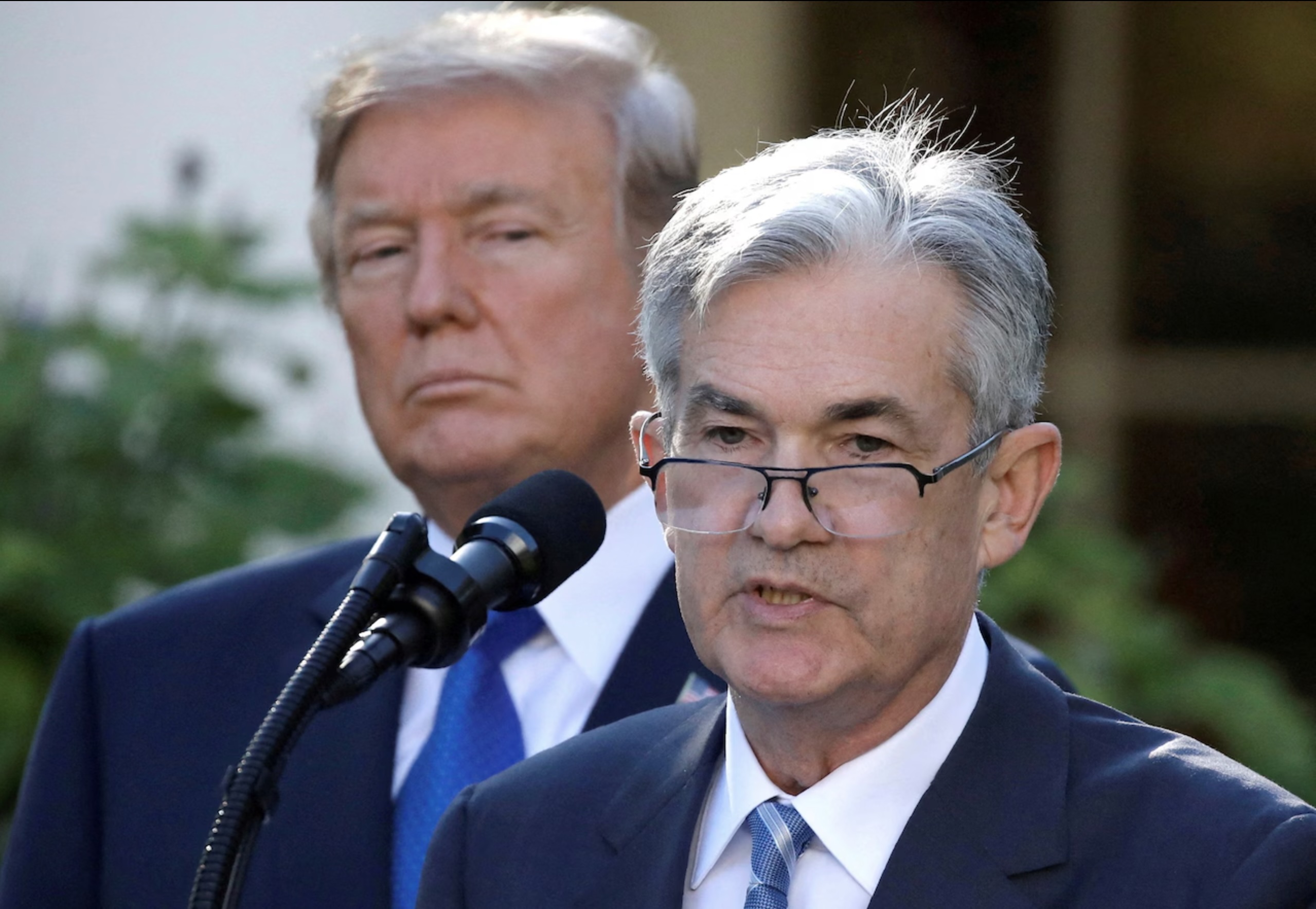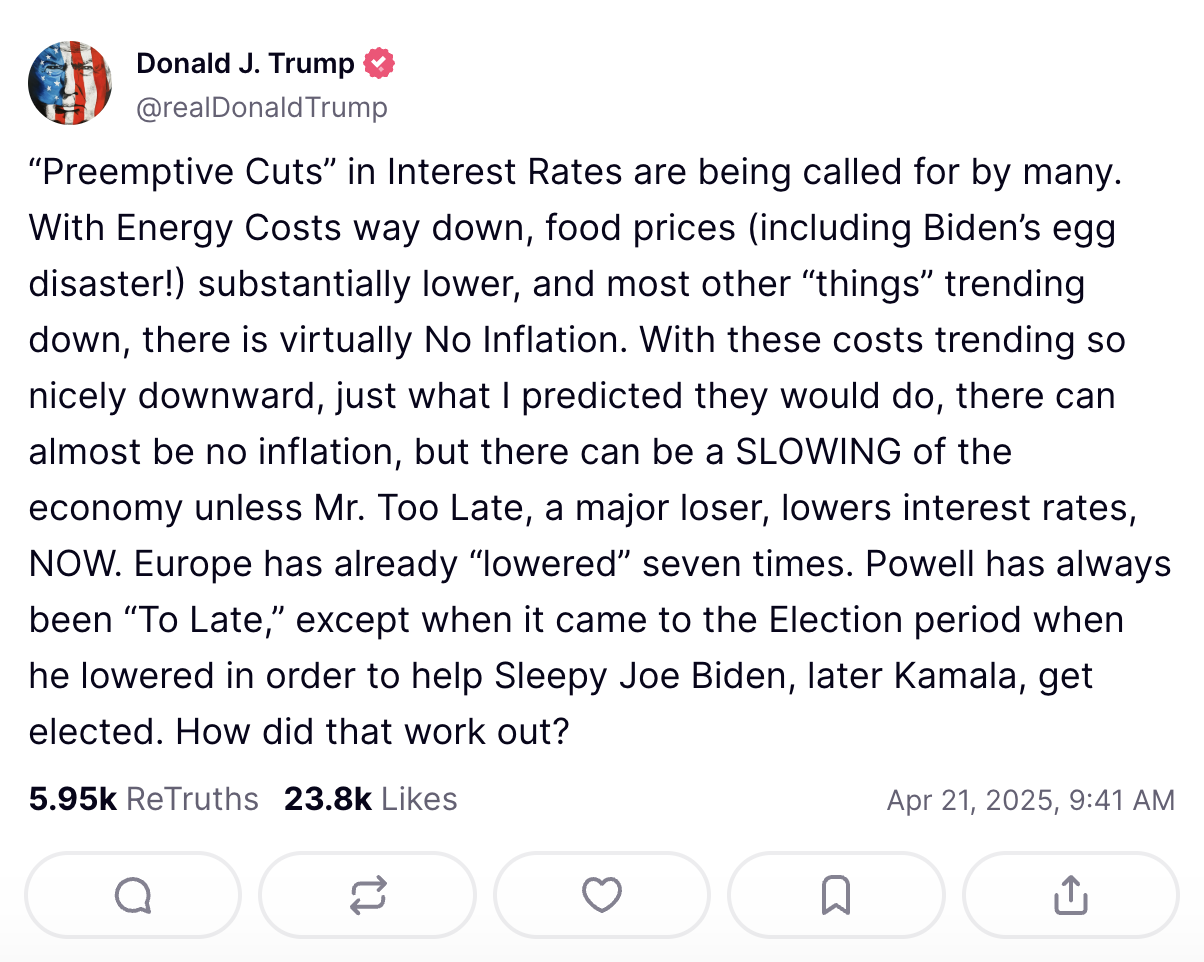Original Title: “If Trump fired Powell, what would happen to crypto?”
Compiled by: Patti, ChainCatcher
In recent months, a specific pattern has repeatedly emerged: U.S. President Donald Trump takes some objectively harmful actions against the U.S. economy, and then the market crashes. Observing this situation, Trump turns to Federal Reserve Chairman Powell, pressuring him to lower the federal funds rate—the interest rate at which the Fed lends to banks. However, the firm Powell resolutely refuses, responding, “No.”
Trump wants to lower interest rates because this would effectively inject capital into the U.S. economy, stimulating economic activity and boosting the market. He believes this would make him appear successful in his governance. Powell, on the other hand, aims to set interest rates based on rigorous economic standards, carefully balancing the Fed's dual mandate of maximizing employment and maintaining price stability.
Additionally, Powell is committed to preserving the Fed's independence from political pressure, especially in maintaining this independence in the eyes of the public. If the market perceives that the independence of the U.S. central bank has been lost, the difficulty of issuing U.S. Treasury bonds may increase. Fundamentally, this means that the U.S. would have to pay a higher cost to borrow funds, which would damage national strength—an issue that is particularly severe now, as the U.S. is burdened with a staggering $30 trillion in debt that requires regular refinancing.
If the market loses trust in the U.S. government and the U.S. is forced to refinance at higher interest rates, the cost of interest will consume a larger proportion of GDP. In contemporary terms, the U.S. would be in trouble.
This game of chess has continued to this day. Last week, Trump hinted multiple times at the intention to fire Powell, and the market reacted poorly. On Monday, Trump criticized Powell on the social platform Truth Social, calling him a “total loser,” which triggered a market crash. In response, U.S. Treasury Secretary Scott Basset reportedly expressed concerns to Trump about the risks of firing Powell. It now seems that Trump has compromised, stating on Tuesday that he would not fire the Fed chairman.

However, this process resembles a spiraling deterioration, with many market observers waiting for the next crisis to erupt. This raises a question: if Trump truly cannot contain his impulse and insists on dismissing Powell, what consequences would follow? In particular, what impact would this have on the cryptocurrency industry?
Challenging the Authority of the Federal Reserve
It should be noted that the president should not have the authority to arbitrarily dismiss the Fed chairman. The Federal Reserve Act of 1913, Section 10, states: “Each member of the Board of Governors of the Federal Reserve System shall be appointed for a term of fourteen years, except that the President may remove any member for cause.”
This wording seems vague, but in the 1935 case of “Humphrey's Executor v. United States,” the Supreme Court ruled that the Constitution does not grant the president “unlimited removal power,” thus the president's removal power is limited by legal provisions.
This ruling established the concept of “independent agencies,” which, while part of the executive branch, possess independent authority. Although several agencies, including the U.S. Securities and Exchange Commission (SEC), the Commodity Futures Trading Commission (CFTC), and the Federal Trade Commission (FTC), share this characteristic, the importance of the Federal Reserve is unparalleled.
Economists rarely focus on the issue of political control over central banks. Politicians' incentives often focus on the short term, with decision-making cycles typically measured in years or election cycles. This tendency makes them more inclined to implement short-term effective policies, and directly injecting funds into the economy is undoubtedly the purest form of short-termism. However, fiscal and monetary policy is a delicate art, often involving difficult policy choices.
A typical case is Richard Nixon, who pressured then-Fed Chairman Arthur Burns to implement expansionary monetary policy before the 1972 election to enhance his chances of re-election. Nixon did win the election by a landslide, but the result was disastrous “stagflation”—a combination of economic stagnation and inflation that severely impacted the U.S. economy for a decade, with effects still lingering in some hollowed-out industries.
In stark contrast, Paul Volcker implemented a series of radical interest rate hikes from 1979 to 1987 after the stagflation crisis, leading to the “Volcker Shock,” which caused multiple painful economic recessions. However, this policy ultimately succeeded in curbing inflation, laying the groundwork for the economic prosperity of the 1990s and contributing to Bill Clinton's outstanding fiscal policies.
These choices are not something politicians can make, nor would any politician dare to do so in the future. This is the crux of the matter—economists, as well as crucial market participants, firmly believe that the Federal Reserve must remain independent; otherwise, the entire economic structure of American society will face the risk of collapse. This is not alarmism—Weimar Germany, Argentina during the Peronist era, and Venezuela, all with politically controlled central banks, have experienced hyperinflation, leading to geopolitical decline for generations, and even situations where people starved and resorted to eating rats, further facilitating the rise of dictators like Adolf Hitler.
If Trump wishes to fire Powell, he must first overturn the precedent set by the “Humphrey's Executor” case. Given the current composition of the Supreme Court, many legal scholars believe this is not impossible. However, crossing this “Rubicon” would mean the president would have comprehensive legal power to arbitrarily direct all executive officials, including the Fed chairman. Most believe this would lead to catastrophic consequences.
But regardless of the outcome, this will be a test for cryptocurrency. The original goal of the Bitcoin white paper was to eliminate the intermediary role of financial institutions as “trusted third parties” in financial transactions. If the Fed falters and U.S. monetary policy deviates from rational judgment, the “decentralization” concept advocated by early cryptocurrencies will face severe challenges.
Recently, Trump has triggered capital flight, with investors seeking safe-haven assets. Traditionally, during a crisis, savvy investors convert risk assets into U.S. Treasury bonds, viewing them as risk-free assets. However, this notion may be outdated. During the peak of the tariff crisis, the yield on ten-year Treasury bonds approached 5% and has yet to fully return to previous lows. If Trump truly destroys the Fed, the current scale of capital outflow will seem trivial, and funds may flood into the cryptocurrency sector.

Note: Trump criticizes Powell, calling him “Mr. Dull.”
Historically, the price of Bitcoin has been highly correlated with the Nasdaq index (albeit with greater volatility). However, since the onset of the tariff crisis, despite the continued slump in U.S. stock prices, Bitcoin's price has miraculously begun to soar. This has led to speculation: are we witnessing the long-predicted phenomenon of “decoupling”—where crypto assets achieve their original mission, breaking free from centralized assets and operating independently?
We cannot assert whether this trend will continue, but if Trump does indeed dismiss Powell, the answer will soon be revealed.
Out of the Frying Pan, Into the Fire
Of course, from a macro-historical perspective, a global collapse is not entirely beneficial for cryptocurrencies; this crisis will also have significant impacts across multiple sectors. The first to face severe consequences will be stablecoins.
Over the past decade, two dollar-pegged stablecoins—USDC and Tether's USDT—have dominated the market. Their issuers, Circle and Tether, are not only important systemic institutions but also major buyers of U.S. Treasury bonds, which are core components of their stablecoin reserves.
If the Fed falls into crisis, one of the most direct consequences will be a sharp increase in the risk of U.S. Treasury bond defaults. Economist Noah Smith has speculated that Trump may attempt to address the U.S. sovereign debt issue through “debt restructuring”:
“I suspect Trump will employ the tactics he is accustomed to in business—when debts cannot be repaid, he will seek low-cost bailouts; if bailouts are hopeless, he will declare bankruptcy outright.”
In fact, Trump himself hinted at this possibility in February of this year, claiming he might reduce the debt scale through some “technical maneuver”:
“There is indeed a risk with U.S. Treasury bonds, and this could become an interesting issue… Perhaps many of those debts simply ‘don’t count.’ In other words, some debts may be fraudulent, so the actual debt scale may be lower than we think.”
If the U.S. experiences a sovereign debt default, the value of the Treasury reserves held by Circle and Tether will directly shrink, leading to insufficient collateral for stablecoins, which could trigger a run on them. Although the market may eventually stabilize, if the situation worsens, the collapse of mainstream stablecoins may become unavoidable.
This shock will create a domino effect: smart contracts collateralized by stablecoins will be forced to liquidate positions, and panic will spread throughout the entire cryptocurrency market.
However, this technical consequence may be “milder” than the political costs triggered by a Fed crisis. After all, for the cryptocurrency market, Treasury bonds are not the only systemic risk asset. The dollar has maintained its status as the global reserve currency for decades, supported by solid logic—the relative strength and stability of the dollar make it the preferred choice for international trade settlements. However, if the U.S. government credit supporting the dollar is no longer stable, this pattern may undergo a fundamental shift.
As more international trade is priced in euros or renminbi, regulatory agencies in the EU and China will gain greater authority to monitor fiat currency flows through cryptocurrency channels. A well-known cryptocurrency industry lawyer, who wished to remain anonymous, stated:
“I believe China will fill part of the market gap, and the EU will occupy the remaining majority. However, whether it is the strict regulation of the Chinese Communist Party or the EU's excessive intervention based on different goals, neither is beneficial for the cryptocurrency industry. This situation is concerning.”
In this context, market funds may shift towards uncollateralized native crypto assets, but such assets have almost no precedent for large-scale trading in the real world. A more likely scenario is that the stablecoin crisis will plunge the burgeoning cryptocurrency industry into a prolonged stagnation.
Ultimately, no one can predict whether Trump will fire Powell, nor can anyone be certain if he truly has that power. Similarly, no one can foresee what chain reactions his decisions will trigger. But just as a butterfly flapping its wings in Argentina could unleash a tornado in Burbank, every “whisper” from Trump in the West Wing could permanently alter the fate of the blockchain industry—either vindicating it or causing its collapse.
Whether we like it or not, this storm is unavoidable.
We can only embark on this unknown journey together.
免责声明:本文章仅代表作者个人观点,不代表本平台的立场和观点。本文章仅供信息分享,不构成对任何人的任何投资建议。用户与作者之间的任何争议,与本平台无关。如网页中刊载的文章或图片涉及侵权,请提供相关的权利证明和身份证明发送邮件到support@aicoin.com,本平台相关工作人员将会进行核查。




